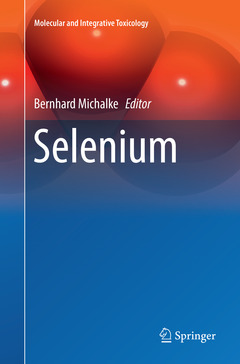Description
Selenium, 1st ed. 2018
Molecular and Integrative Toxicology Series
Coordinator: Michalke Bernhard
Language: English
Subject for Selenium:
Publication date: 01-2019
Support: Print on demand
Publication date: 11-2018
Support: Print on demand
Description
/li>Contents
/li>Biography
/li>Comment
/li>
This book summarizes the fast-growing and current knowledge about selenium interaction with cancer, diabetes, neuro-degeneration, heart disease, muscle disorders, HIV and several more. A special focus will be placed on in-depth knowledge about gene expression, selenoprotein biosynthesis, seleno-metabolism--as well as the molecular pathways, physiological roles, and the molecular action of selenium including interaction with other elements and vitamins or as Se-nanoparticles. The reader will receive the newest information regarding redox status and redox regulatory systems, specifically in relation to different glutathione peroxidases and thioredoxin-reductases as well as about cellular bioavailability and cytotoxicity, de-balanced immune response, inflammation or dietary aspects.
Part I - Overview: 1. Selenium in Human Health and Disease: an Overview.- Part II - Bioaccessibility and Dietary Aspects of Selenium: 2. Selenium in Soils and Crops.- 3. Dietary Aspects for Selenium and/or Selenium Compounds.- Part III - Genes, Proteins, Pathways, and Metabolism Related to Selenium: 4. Contribution of the Yeast Saccharomyces Cerevisiae Model to Understand the Mechanisms of Selenium Toxicity.- 5. Selenium Metabolism, Regulation And Sex Differences In Mammals.- Part IV - The Role of Selenium within Redox System, Inflammation, and Thyroid Interaction: 6. Oxidative Stress, Selenium Redox Systems Including GPX / TXNRD Families.- 7. Selenium and Inflammatory Mediators.- 8. Selenium and Thyroid Function.- Part V - The Role of Selenium in Neurodevelopment and Neurological Disorders: 9. Selenium and Neurodevelopment.- 10. Selenium and Autism Spectrum Disorder.- 11. Selenium in Ischemic Stroke.- 12. Selenium neurotoxicity and Amyotrophic Lateral Sclerosis: An Epidemiologic Perspective.- Part VI - The Role of Selenium in Cancer: 13. Therapeutic Potential of Selenium Compounds in the Treatment of Cancer.- 14. Selenocystine and Cancer.- 15. Selenium in Radiation Oncology.- Part VII - The Role of Selenium in Various Diseases and Health Issues: 16. Selenium and Cardiovascular Disease: Epidemiological Evidence of a Possible U-Shaped Relationship.- 17. Selenium and Diabetes.- 18. Uncovering the Importance of Selenium in Muscle Disease.- 19. Selenium in Immune Response and Intensive Care.- 20. Selenium and Toxicological Aspects: Cytotoxicity, Cellular Bioavailability and Biotransformation of Se-Species.- 21. Selenium Nanoparticles -Biomedical Application.- 22. Selenium Interactions with Other Trace Elements, with Nutrients (and Drugs) in Humans.- Part VIII - Selenium Analytics, Speciation and Biomonitoring: 23. Biomarkers of Selenium Status.- 24. Human Biomonitoring of Selenium Exposure.- 25. Bioanalytical Chemistry of Selenium.
Bernhard Michalke is head of the research group "Elements and Element Speciation" and of the "Central Inorganic Analysis Division" as well as deputy director of the research unit "Analytical BioGeoChemistry" at the Helmholtz Zentrum München - German Research Center for Environmental Health. He is also a lecturer at the Institute of Analytical Chemistry and Food Chemistry of the Technical University of Graz, Austria, which is where he received his habilitation in analytical chemistry. His research interests encompass speciation projects related to environmental health, i.e. the exposure and chemical speciation of neurodegenerative elements such as manganese, iron, copper or selenium and species-related neurotoxic effects in the central nervous system. He has published more than 200 peer reviewed articles and 10 book chapters. He has been and continues to be a co-organizer of several international conferences.
Contains the newest information regarding redox status and redox regulatory systems, specifically in relation to different glutathione peroxidases and thioredoxin-reductases
Summarizes the fast-growing and current knowledge about selenium interaction with disease
Special focus on gene expression, selenoprotein biosynthesis and seleno-metabolism
Coverage ranges from analytical protocols to environmental deposits of selenium and metabolic pathways of its use in humans

